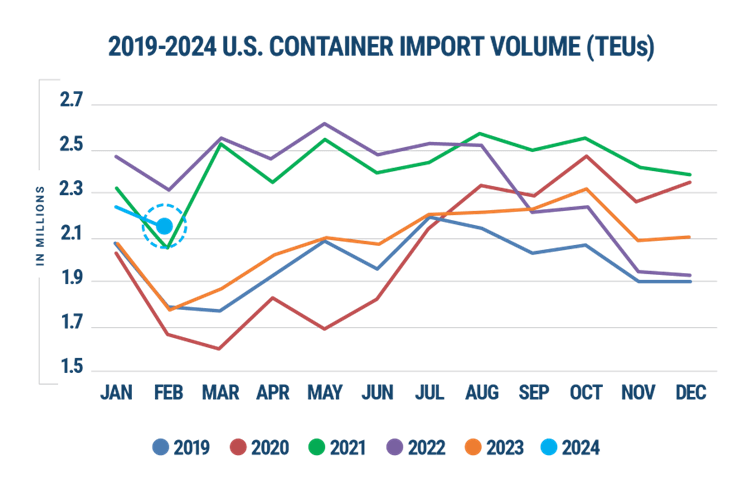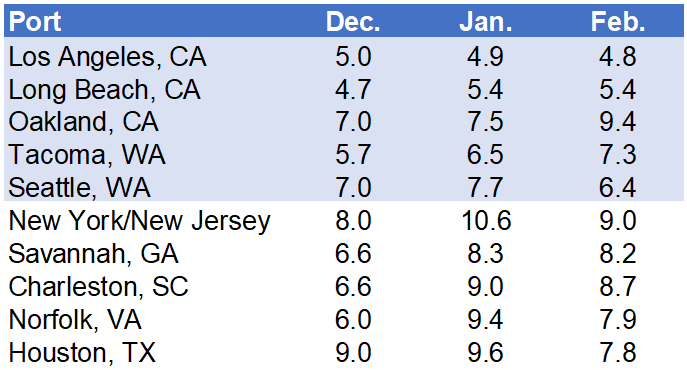In February 2024, trade data tracked a 6% decline in U.S. import volume from January. Conversely, import volumes surged by 23.3% compared to the same month last year. Despite conflicting figures, a deeper analysis suggests February remained strong, with overall volume surpassing the two million TEU mark. The potential impact of the Chinese Lunar New Year holidays and February’s shorter duration should be considered.
Imports from China reversed their robust growth in February compared to January 2024, affecting West Coast ports, particularly the Port of Long Beach. Lower import volumes contributed to improved port transit delays, as the Panama drought and Middle East conflict had less impact on top East and Gulf Coast ports. While 2024 starts as a strong year for U.S. container imports, ongoing conditions at the Panama and Suez Canals, and upcoming labor negotiations at South Atlantic and Gulf Coast ports, may impact global supply chain performance.
U.S. import volumes in February 2024 decreased by 6.0% from January 2024 to 2,137,724 TEUs. But it represented a 23.3% increase from February 2023 and a 19.5% rise from pre-pandemic February 2019 levels. Several factors contributed to the sharp year-over-year increase, including the leap year in 2024 and the timing of the Chinese Lunar New Year. Descartes analyzed TEU volume for the first 15 days of February (factoring out the effects of the Chinese Lunar New Year) for both years to gain clarity on the year-over-year performance, revealing a growth of 13.3%, more representative of consumer-fueled pandemic
Figure 1: U.S. Container Import Volume Year-over-Year Comparison

Source: Descartes Datamyne™
Port Transit Times Improve, particularly on the East Coast
Port transit delays witnessed a notable reduction in February (See Figure 2), especially evident at East Coast ports. Overall, port transit delays declined across major ports, except for increases noted at the Ports of Oakland and Tacoma. Notably, the top East Coast ports experienced decreases, with the Port of Houston leading the decline with a notable decrease of 1.8 days in transit delays.
Figure 2: Monthly Average Transit Delays (in days) at the Top 10 Ports

Source: Descartes Datamyne™
Note: Descartes’ definition of port transit delay is the difference as measured in days between the Estimated Arrival Date, which is initially declared on the bill of lading, and the date when Descartes receives the CBP-processed bill of lading.
Impending Labor Disruption Threatens South Atlantic and Gulf Coast Ports
The agreement between the International Longshoremen’s Association (ILA) and the United States Maritime Alliance (USMX) is slated to lapse by September 2024, potentially leading to labor unrest at South Atlantic and Gulf Coast ports. ILA leadership’s refusal to extend the current agreement signals the likelihood of a coast-wide strike in October 2024. Despite ongoing negotiations, there has been no progress reported by either organization, heightening concerns over potential disruptions to port operations.
Managing Supply Chain Risks with Global Shipping Data
February 2024 trade data indicated a U.S. import dip from January but volume growth of about 13% compared to February 2023. Port transit times decreased from January. Persistent challenges in Panama and the Middle East threaten global supply chains, anticipating disruptions throughout 2024. Descartes uses critical data sources, including Descartes Datamyne and U.S. government insights, to offer ongoing insights into global shipping. Recommendations remain consistent with Descartes’ February Global Shipping Report.
Descartes Datamyne shipping analysis covers various aspects affecting global shipping and supply chains. For example, February’s U.S. container import volumes decreased to 2.1M TEUs, alleviating pressure on ports. Meanwhile, port transit times decreased overall, though East and Gulf Coast ports still experience delays. The pandemic’s lingering impact adds uncertainty, while conflicting economic indicators pose challenges. Issues like the Panama Canal’s capacity and the Middle East conflict loom large, potentially disrupting shipping routes. Contract negotiations between ILA/USMX pose further risks, potentially affecting U.S. container imports later in 2024.
To alleviate stress, shippers and logistics providers have strategies they can deploy, including using global shipping data to mitigate supply chain risk with the key objective of keeping their international business healthy and growing, and maintaining a satisfied customer base. These strategies include:
- Short Term: Track the spread of COVID variants, monitor ocean shipments and carrier performance, and assess the Panama Canal situation due to potential rerouting. Stay updated on the Middle East conflict as carriers divert shipping around Africa, impacting capacity. Evaluate inflation and geopolitical conflicts’ impact on logistics costs, ensuring compliance. Assess the potential ILA strike’s impact on South Atlantic and Gulf Coast ports for contingency planning.
- Long Term: Assess supplier and factory distribution to reduce dependence on strained trade routes and conflict-prone regions. While concentration of suppliers offers economies of scale, it also increases risk. The pandemic and ensuing logistics challenges underscore this vulnerability. Conflict situations develop gradually, necessitating proactive measures to prevent business disruptions.
The goal here is to implement comprehensive strategies for immediate and future challenges. By assessing and tracking COVID variants, monitoring shipments, and evaluating geopolitical situations, businesses can ensure operational continuity. In the long term, assessing supplier distribution mitigates reliance on vulnerable routes, promoting resilience in the face of evolving global dynamics. Proactive measures address immediate risks and strengthen supply chains against future disruptions.
How Datamyne Global Shipping Data can Help Manage Supply Chain Risks
Descartes Datamyne delivers global trade and shipping data with comprehensive, accurate, up-to-date, import information that helps companies save significant time in spotting supply and demand shifts, optimizing trade lanes, expanding into new markets and identifying new buyers and suppliers.
Datamyne features the world’s largest searchable trade database covering 230 markets across five continents. Gathered directly from official filings with customs agencies and trade ministries, including bills of lading, our data is detailed (down to company names and contact details), timely and authoritative.
Apart from providing trade intelligence via shipping data, Descartes software solutions also include a landed cost tool to calculate the economic viability of importing from a range of markets. Our applications can also screen against multiple denied parties lists simultaneously to help ensure organizations are not doing business with entities named on official government watch lists.
This is an excerpt of an article originally posted in the Descartes Global Shipping Crisis Resource Center. If you are looking for how Datamyne’s global trade and shipping data can help you, Contact Us.
Note: This report uses the initial compiled release of U.S. Customs and Border Protection (CBP) data and is subject to revision at a later date by CBP. The revised data can be seen in Descartes Datamyne.



